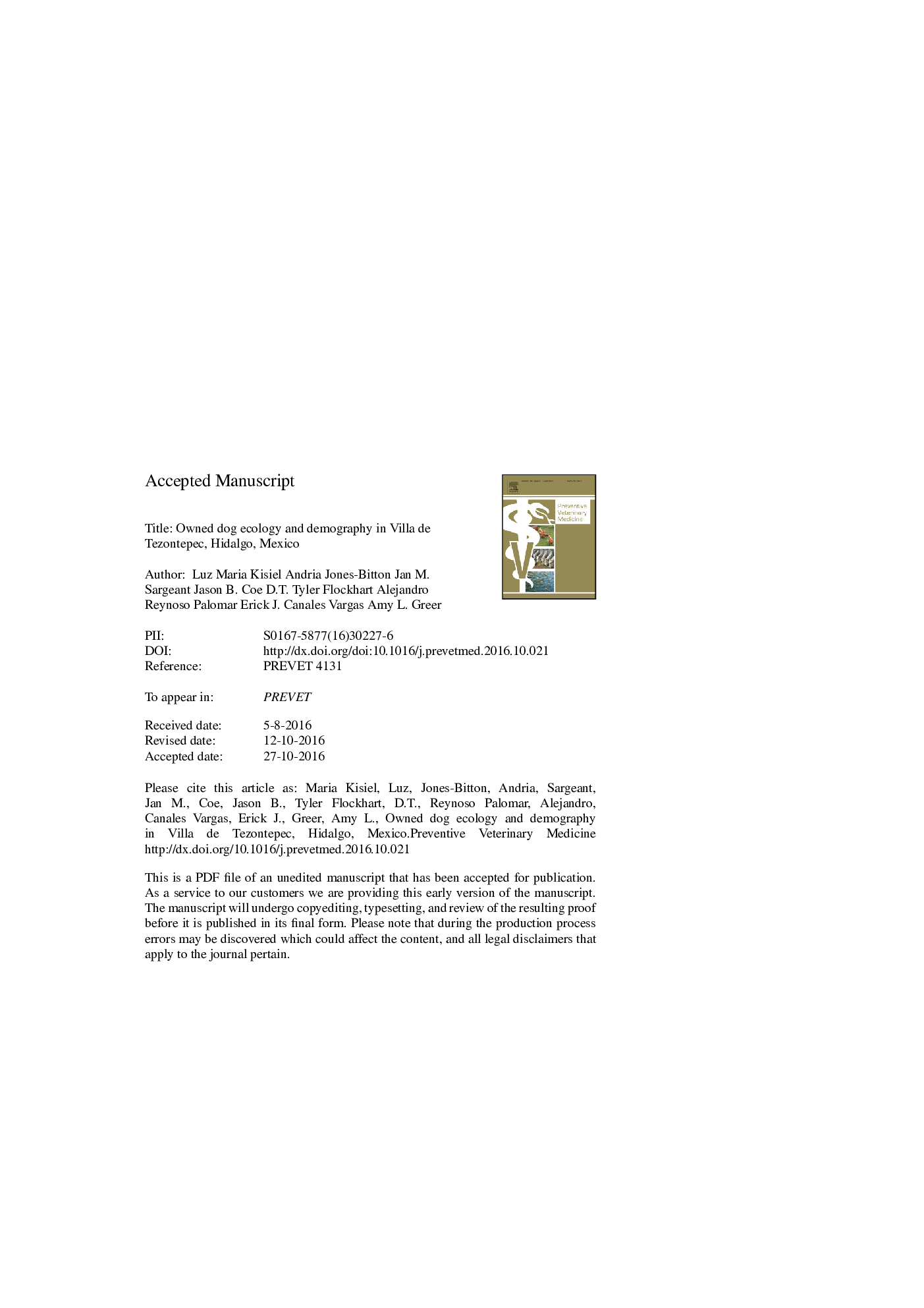| کد مقاله | کد نشریه | سال انتشار | مقاله انگلیسی | نسخه تمام متن |
|---|---|---|---|---|
| 5543686 | 1554153 | 2016 | 51 صفحه PDF | دانلود رایگان |
عنوان انگلیسی مقاله ISI
Owned dog ecology and demography in Villa de Tezontepec, Hidalgo, Mexico
ترجمه فارسی عنوان
محیط زیست و جمعیت شناسی سگ ها در ویلا دو تئونستپک، هیدالگو، مکزیک
دانلود مقاله + سفارش ترجمه
دانلود مقاله ISI انگلیسی
رایگان برای ایرانیان
کلمات کلیدی
مکزیک، دموگرافی سگ، سگ خانگی، بیش از حد سگ، مدیریت جمعیت، فرم نظرسنجی،
موضوعات مرتبط
علوم زیستی و بیوفناوری
علوم کشاورزی و بیولوژیک
علوم دامی و جانورشناسی
چکیده انگلیسی
Dog overpopulation in developing countries has negative implications for the health and safety of people, including the transmission of zoonotic diseases, physical attacks and intimidation to humans and animals, as well as impacts on canine welfare. Understanding the ecology and demographic characteristics of a dog population can help in the planning and monitoring of canine population control programs. Little data exist regarding demography and dynamics of domestic dog populations in semi-urban areas in Mexico. A cross-sectional study was carried out between October 21 and November 7, 2015, to characterize the dog ecology and demography in Villa de Tezontepec, Hidalgo, Mexico. A face-to-face survey was used to collect data from randomly selected households in four contiguous communities using stratified two-stage cluster sampling. Within each household, adults answered questions related to their dogs and their experiences with dog bites and aggression. A total of 328 households were interviewed, representing a participation rate of 90.9% (328/361) and 1,450 people. Approximately 65.2% of the households owned one or more dogs, with a mean of 1.3 (SDÂ =Â 1.5) and 2.0 (SDÂ =Â 1.5) owned dogs in all participant households and dog-owning households, respectively. The human: owned dog ratio for all participant households was 3.4:1 (1450/428), and for the dog-owning households was 2.3:1 (984/428). The owned dog male: female ratio was 1.4:1 (249/179). Approximately 74.4% (95.0% CIÂ =Â 69.8% - 78.7%) of the owned dogs were older than one year (mean age: 2.9 years; SDÂ =Â 2.5). The mean age of owned female dogs at first litter was 1.9 years (SDÂ =Â 1.2) and the mean litter size was 4.2 puppies (SDÂ =Â 2.1). Approximately 36.9% (95.0% CIÂ =Â 31.8% - 46.4%) of the females were spayed, and 14.1% (95.0% CIÂ =Â 10.7% - 19.7%) of the males were neutered. Only 44.9% (95.0% CIÂ =Â 40.1% - 49.7%) were always confined when unsupervised. Approximately 84.4% (95.0% CIÂ =Â 80.6% - 87.7%) were reported to have been vaccinated against rabies in 2015. The knowledge of owned dog demography and ecology provided by this study can inform local government planning of dog population control interventions, and could serve as a baseline for the development of agent-based models to evaluate the effects of different dog population control strategies on dog demography.
ناشر
Database: Elsevier - ScienceDirect (ساینس دایرکت)
Journal: Preventive Veterinary Medicine - Volume 135, 1 December 2016, Pages 37-46
Journal: Preventive Veterinary Medicine - Volume 135, 1 December 2016, Pages 37-46
نویسندگان
Luz Maria Kisiel, Andria Jones-Bitton, Jan M. Sargeant, Jason B. Coe, D.T. Tyler Flockhart, Alejandro Reynoso Palomar, Erick J. Canales Vargas, Amy L. Greer,
